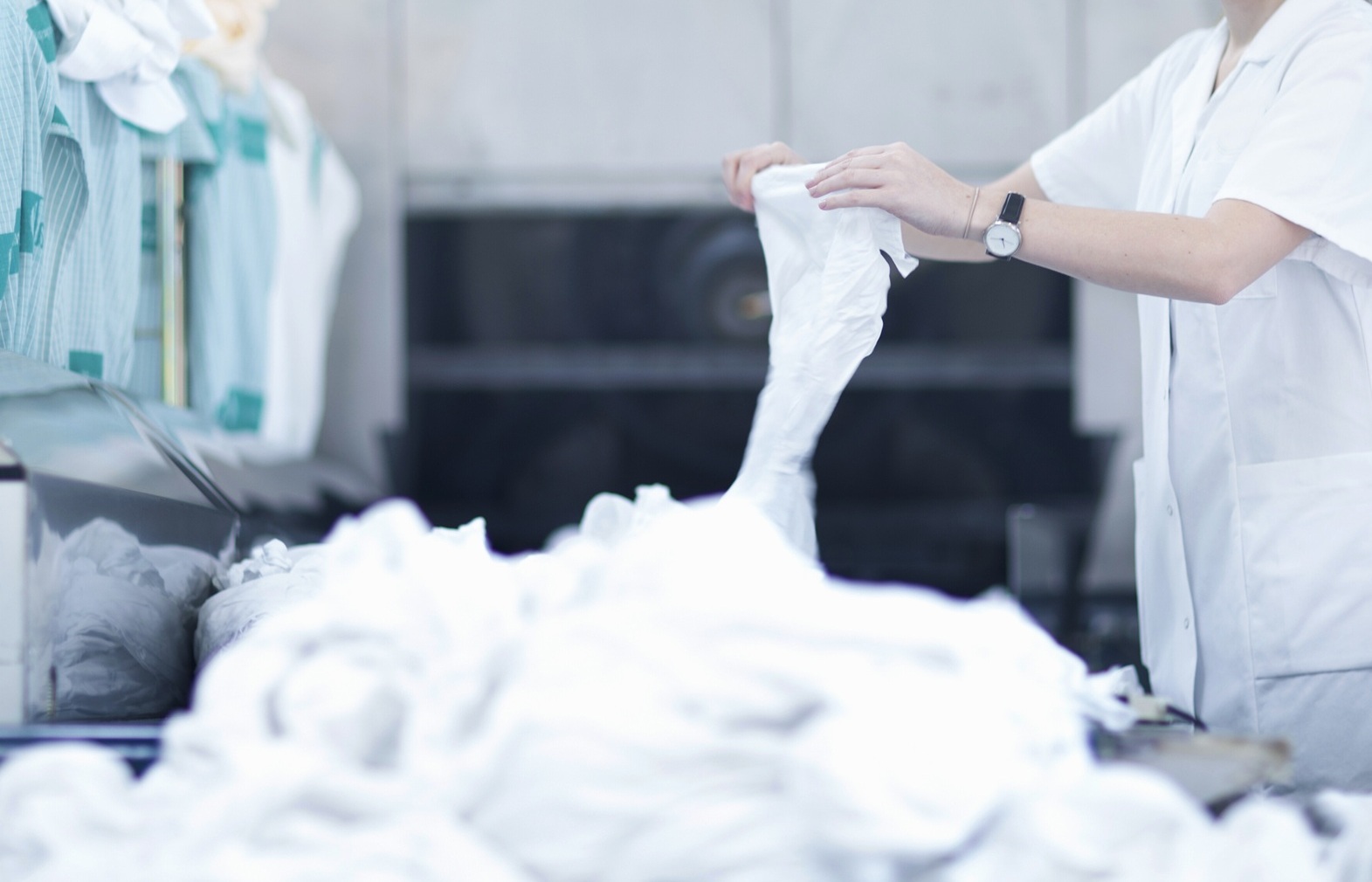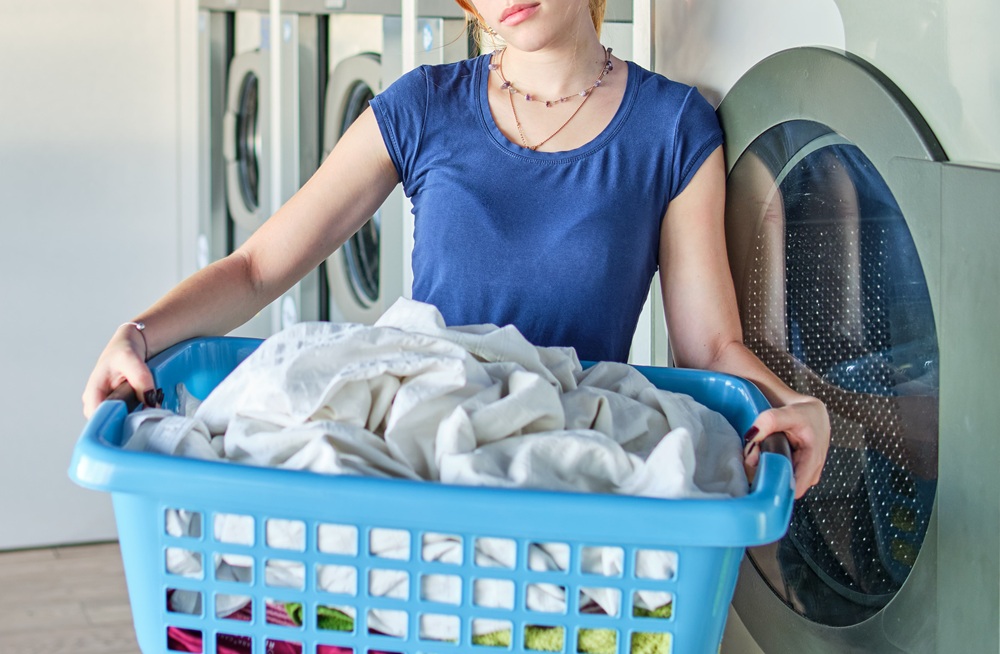
Handling laundry at home can be time-consuming enough. Now imagine that on the scale of a hotel or hospital, with hundreds of linens that need to be spotless every single day. It’s a nonstop cycle that requires focus, coordination, and reliable systems. And as a manager or operator, you can’t afford inefficiencies.
In this post, we share five of the best practices that help busy establishments like yours stay ahead, efficient, and always ready for the next load.
Sorting and Organizing Laundry Efficiently
When hundreds of pounds of linens, towels, and uniforms come in daily, having a clear sorting system ensures items are cleaned properly, tracked easily, and delivered on time. The goal is to keep everything flowing efficiently while minimizing mix-ups and rework.
How to Properly Sort Your Items
1. Separate fabrics by type and soil level.
Cotton, polyester, microfiber, and linen all have different wash needs. Separating by fabric type protects delicates and optimizes water temperature. Heavily soiled items, like kitchen aprons or gym towels, should always be washed separately to avoid transferring grime.
2. Label linens and uniforms for easy tracking.
In commercial operations around Salt Lake City, barcodes or RFID tags are used to trace every item from wash to delivery. For smaller setups, color-coded tags or washable labels work great to identify departments, customers, or room assignments.
3. Set up a color-coded or category-based system.
Many hotels and resorts use simple systems: blue for bedding, green for towels, red for uniforms. This makes sorting visual and quick, especially for new staff. A well-labeled bin setup saves hours each week and reduces lost or mixed-up items.
When your sorting system is tight, everything downstream, from washing to folding, runs more predictably. Once your laundry is organized, the next step is investing in the right equipment to handle large loads efficiently.
Choosing the Right Equipment and Supplies
High-volume laundry requires machinery that can keep up with demand. If you’re washing linens for a resort near the Wasatch Range or uniforms for a business district in Salt Lake City, equipment choice can make or break your turnaround time. The right setup helps you maintain fabric quality, save water, and control costs, all while delivering fresh, spotless results.
How to Equip Your Laundry Facility Like a Professional
1. Invest in high-capacity washers and dryers.
Commercial washers can handle hundreds of pounds at once and often include programmable cycles for fabric-specific care. For example, bedding might need a gentler spin, while uniforms benefit from longer, hotter washes.
2. Use commercial-grade detergents and stain removers.
Regular home detergents won’t cut it when you’re cleaning for hotels or Airbnb properties. Commercial formulas are concentrated, handle stains like oil or mud from mountain biking trails, and leave textiles feeling fresh longer.
3. Monitor water temperature for fabric safety.
Hot water sanitizes but can fade colored fabrics or shrink natural fibers. Smart systems can auto-adjust temperature by load type, ensuring durability while maintaining hygiene, which is especially important in hospitality and healthcare settings.
Choosing the Right Equipment and Supplies
High-volume laundry requires machinery that can keep up with demand. If you’re washing linens for a resort near the Wasatch Range or uniforms for a business district in Salt Lake City, equipment choice can make or break your turnaround time. The right setup helps you maintain fabric quality, save water, and control costs, all while delivering fresh, spotless results.
How to Equip Your Laundry Facility Like a Professional
1. Invest in high-capacity washers and dryers.
Commercial washers can handle hundreds of pounds at once and often include programmable cycles for fabric-specific care. For example, bedding might need a gentler spin, while uniforms benefit from longer, hotter washes.
2. Use commercial-grade detergents and stain removers.
Regular home detergents won’t cut it when you’re cleaning for hotels or Airbnb properties. Commercial formulas are concentrated, handle stains like oil or mud from mountain biking trails, and leave textiles feeling fresh longer.
3. Monitor water temperature for fabric safety.
Hot water sanitizes but can fade colored fabrics or shrink natural fibers. Smart systems can auto-adjust temperature by load type, ensuring durability while maintaining hygiene, which is especially important in hospitality and healthcare settings.
Implementing Safe and Sanitary Practices
When handling large volumes of laundry, especially for hospitals, restaurants, or university dorms, cleaning isn’t just about removing stains. It’s about protecting both customers and staff from contamination. Sanitizing practices are essential in any commercial laundry service, where cleanliness and trust go hand in hand.
How to Maintain Hygiene Standards in Every Load
1. Prevent cross-contamination between loads.
Use designated bins or carts for soiled versus clean items. Avoid reusing bags unless they’re fully sanitized. Many facilities implement a “clean zone” and a “dirty zone” separation to keep workflows safe.
2. Follow hygiene protocols for healthcare and food-service items.
Hospital and restaurant linens often require specialized detergents with disinfecting agents. These items are washed at higher temperatures and handled with gloves to maintain compliance with health codes.
3. Train staff on safety and fabric handling.
Proper training reduces accidents and ensures consistent quality. Teach employees to read labels, use gloves and masks when handling heavily soiled items, and check for sharp or foreign objects before washing.
Maintaining sanitary practices doesn’t just protect customers; it protects your reputation. Once your team masters hygiene, it’s time to look at how to schedule and manage all that laundry without falling behind.
Scheduling and Workflow Management

In high-volume laundry environments, like resorts near Deer Valley or student housing at Utah State University, workflow management can make or break your business. Without a clear schedule, machines get overloaded, staff get overwhelmed, and turnaround times suffer. The trick is to create a system that flows steadily instead of in chaotic waves.
How to Plan a Laundry Schedule That Works for Your Business
1. Create a consistent laundry rotation schedule.
Assign specific days or time slots for different categories, like bedding on Mondays, towels mid week, and uniforms at week’s end. This keeps your workload predictable and helps avoid machine congestion.
2. Avoid bottlenecks during peak business hours.
For hotels and motels, mornings are often the busiest. Schedule washing during off-peak hours, like late evenings or early afternoons, to make use of available machine time and staff energy.
3. Use checklists to keep operations smooth.
A simple checklist helps track which batches are washed, dried, folded, or awaiting delivery. Many laundries use digital dashboards or shared documents so everyone stays updated in real time.
Good scheduling means less stress, faster turnaround, and happier customers. Once your internal workflow is stable, the next decision is when to handle laundry in-house and when to bring in professional support.
Leveraging Professional Support When Needed
Sometimes, running laundry inhouse just isn’t efficient. Maybe your washers can’t keep up, or maybe the busy ski season in Utah’s Wasatch Range has doubled your usual volume. Outsourcing parts of your operation to a Commercial Laundry Service can actually save you money, time, and headaches.
When to Partner with a Professional Laundry Provider
Here’s when it’s time to call in the professionals and how to make the most of those partnerships.
1. Know when inhouse laundry is inefficient.
If your team spends more time troubleshooting machines than folding clean linens, it’s time to rethink. Large-scale facilities can process higher loads faster and with more consistent results.
2. Partner with a reliable commercial laundry provider for overflow.
During busy seasons, local providers can pick up, wash, and deliver your extra loads. Look for those offering Pickup and Delivery Service, transparent pricing, and responsive customer support.
3. Save staff time by outsourcing high-volume or specialty loads.
Items like banquet linens, spa robes, or chef uniforms require specific care. Outsourcing frees up your team to focus on customer service and core operations instead of laundry bottlenecks.
Professional laundry partners often use mobile apps for tracking, email alerts for delivery schedules, and flexible payment systems, making collaboration seamless. By combining inhouse efficiency with external support, your laundry operations can scale up smoothly during peak business periods without sacrificing quality or service.
Looking for a Commercial Laundry Partner in Salt Lake City? Partner with Red Hanger Cleaners!
When your business depends on crisp linens, spotless uniforms, and quick turnarounds, partnering with a reliable laundry team makes all the difference. That’s exactly what Red Hanger Cleaners has been providing for decades – professional laundry solutions built around the needs of Utah’s busiest establishments.
Founded in 1961, Red Hanger Cleaners started as one small neighborhood cleaner and has grown into Utah’s largest and most trusted dry cleaning and laundry service. Locally owned and community driven, we take pride in delivering quality, convenience, and care through every step of our services.
From our experienced commercial laundry staff to our friendly delivery drivers, we make sure every item that comes through our doors is handled with the highest level of attention.
If your business needs a dependable Commercial Laundry Service Provider in Salt Lake City, let Red Hanger Cleaners lighten the load. Call (801) 405-3312 or email customercare@redhanger.com today to schedule your first FREE Pickup and Delivery Service.